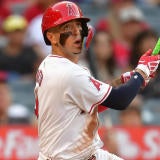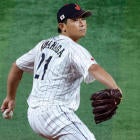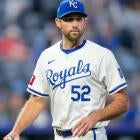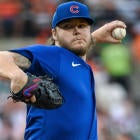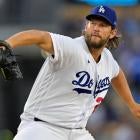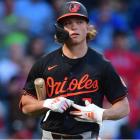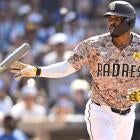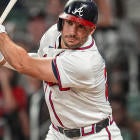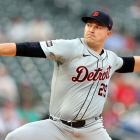
In today's mailbag, we've got plenty of questions about Salary Cap/Auction leagues, keeper strategy, sleeper pitchers, and more. I'll be doing these pretty regularly throughout the season -- perhaps once a week if there's enough interest! -- and it's your opportunity to drive the conversation. Send your questions to FantasyBaseball@CBSi.com with the subject line "AskFBT" to be included, either here or in our weekly mailbag episodes of the podcast.
Let's get to your questions!
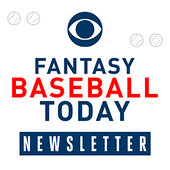
Fantasy Baseball Today Newsletter
Your Cheat Code To Fantasy Baseball
You're destined to gain an edge over your friends with advice from the award-winning FBT crew.
Thanks for signing up!
Keep an eye on your inbox.
Sorry!
There was an error processing your subscription.
ASKFBT Mailbag
- Matthew: For a 12-team 5x5 roto salary cap league, do you veer more towards Stars-and-Scrubs approach or a Spread-the-Wealth? And who are your top Scrub options ($1-$2 players) for each position?
I think it depends on the scoring format and league depth, first of all. In a 12-team, standard Rotisserie league, I'm more likely to try to go with a more balanced approach, but I put the emphasis on "try" there for a reason: I often don't have the discipline for it, and I end up being more aggressive with stars than I'll sometimes intend to. Know thyself, be aware of where your strengths and weaknesses as a drafter are, and try to account for them would be my first bit of advice.
I think the stars-and-scrubs approach works a bit better in a H2H points league, or any league with shallower rosters, just because the quality of the $1-2 players will tend to be a lot better, as will the replacement level on the waiver-wire. In the H2H points league we drafted this week, I got Chris Paddack, Eloy Jimenez, Willson Contreras, and Reid Detmers as $1-3 players. Here are some of my other favorite players who went for $3 or less in that draft:
- Nestor Cortes, SP, NYY -- $3
- Josh Jung, 3B, TEX -- $3
- Nolan Gorman, 2B, STL -- $3
- Noelvi Marte, 3B, CIN -- $2
- Jung-Hoo Lee, OF, SF -- $2
- Jake Burger, 3B, MIA -- $2
- Brandon Lowe, 2B, TB -- $2
- Rhys Hoskins, 1B, MIL -- $2
- Luis Severino, SP, NYM -- $2
- Bo Naylor, C, CLE -- $2
- Junior Caminero, 3B, TB -- $1
- Yusei Kikuchi, SP, TOR -- $1
- Willy Adames, SS, MIL -- $1
In a Roto league, where you have to draft a more balanced roster and more players will be off the board, it's probably more important to save some money for later in the draft. I still want to try to get at least two of the first-round caliber hitters – which I classify as anyone up to Bryce Harper at No. 19 in my rankings – but once I've got two $35-ish players, I'm probably trying to make sure I don't have another player above $25. It's going to be harder to do that if you're the team who drafts Ronald Acñua, because he's going to be a $60-plus player in most leagues. I also wonder if we're going to have a bit of price inflation for the non-Acuña first-rounders once people see how much he's going for.
That's one of the things that's impossible to account for before the draft actually begins, and you'll have to adjust based on what you're seeing from your leaguemates. But, no matter which approach you opt for, I'll say it's important to leave about 20% of your budget for the second half of the draft – enough that you can still afford to go $1-3 up on a player you really want, but not so much that you miss out on the best players. And I would always err on the side of being too aggressive with my high-end players, rather than leaving too much money for players who just aren't likely to be difference makers. I'd rather overpay and have three first-round caliber hitters and have to fill out my roster with more $1 guys than I'd prefer than end up with no first-round players.
- Anthony: My question is around how keepers should impact draft strategy. I'm in a 12-Team Roto League that does a Salary Cap Draft, and I have Spencer Strider and Edwin Diaz as keepers for a combined $5. I'd like to know if you think it is more wise to invest in elite offense or to double down on elite pitching. Pairing Strider and Diaz for that cheap with a Corbin Burnes, Gerrit Cole, another top closer, etc. could lock up a stacked staff in an environment where pitching is so unpredictable, but I could also bank on my keepers to raise my pitching floor and invest early in top of the line offense with the knowledge that I already have my ace. Thoughts?
I love the idea of pairing two aces together to anchor my pitching staff, and while that's usually more like two top-15 starters, being able to pair Strider with Burnes is a super-charged version of that idea. You might be locking in 500 strikeouts with just those two guys, which gives you a lot more flexibility for how you build the rest of your staff.
I might make that my first priority on Draft Day if I'm in your position, but after that, I'm going all-in on hitting. Burnes and Strider together give you a solid enough base that I might not draft another pitcher for more than $10 the rest of the way. That means I'm probably left with $200-plus to spent on 14 hitter spots, and I'm making sure I get at least one first-round caliber hitter to go with my two first-round caliber pitchers.
Now, the thing to keep in mind for Salary Cap drafts featuring keepers is, you're going to have to deal with inevitable inflation. Just look at your team for why: I've got Diaz and Strider for $49 combined, and you're keeping them for $5. That means there's $44 extra in the draft pool. Even if the rest of your league isn't getting discounts quite that steep, the league as a whole probably has a surplus of roughly $300 to spend, with the highest-end players likely primarily off the board. That money still has to get spent, and that leads to inflation for the remaining players. That inflation will almost certainly impact the highest-end players remaining, leaving plenty of $1-5 players later on. I'd try to be as aggressive as possible with stars, given this start.
- Rose: I am wondering which of these two great players I should keep, Vladimir Guerrero for $26 or Trea Turner for $30. I can only keep four players and I already have William Contreras for $8 and Spencer Strider for $6 and Mookie Betts for $29. What would you do?
Alright, one more. When you're talking about the highest-end players, I think price matters less than which player is better. Turner is a first-rounder for me in Roto, while Guerrero is a third-round pick. The difference in my valuations for them is $8, but you can look at it another way: Would you rather have a first-round pick or a third-round pick and an 18th-rounder? You'd rather have the first-rounder.
- Lewis: Just finished listening to the SP preview podcast. I feel like many people aren't appreciating the effects of the six-man rotation on the Dodgers SPs in 2024. Even if Glasnow and Yamamoto crush it in 2024, they're very unlikely to pitch 180 innings simply because they're not going to have enough games started. And they will almost never have two-start weeks.
Most innings pitched by an Angels SP the past three years:
- 2023: 148.2
- 2022: 166
- 2021: 130.1
The Dodgers will definitely have to get creative with their rotation, because pretty much every option they have comes with significant workload concerns. Tyler Glasnow and James Paxton have just never been healthy; Clayton Kershaw is currently not healthy while recovering from shoulder surgery; Walker Buehler threw just two innings last season while recovering from Tommy John surgery; Yoshinobu Yamamoto has been throwing on five-day's rest his entire career in Japan; Bobby Miller, Emmett Sheehan, Gavin Stone, and the rest of the young guys just don't have the experience of throwing 180-plus innings yet. And this is a team with designs on playing deep into October. So yeah, they're going to have to get creative.
But, though the idea of a six-man rotation has been floated, that's already been more or less written off by the team, at least as a full-time option. There may certainly be times when they opt for a six-man rotation, but president of baseball operations Andrew Friedman has already told reporters he thinks a full-time, six-man rotation would leave them too shallow out of the bullpen.
Now, that being said, I'd be stunned if any Dodgers pitcher got to 200 innings as is. If the Dodgers got 60 innings out of Paxton and Glasnow but both were healthy for the playoffs, I think they'd probably view that as a win; it certainly wouldn't be for Fantasy, especially not at Glasnow's price. But the good news is, the market has mostly priced those concerns in. Glasnow is the only one of the team's pitchers I think is really being drafted at his ceiling right now, based on ADP, and if we get 170-180 innings from Yamamoto and Miller in particular, I'd be thrilled at their going rates.
- James: I'd love to hear someone make the negative case for Shota Imanaga at his current ADP. His high K rate last year in Japan, Cubs defense, and current price have me drafting him pretty much everywhere right now. I'm thinking that maybe I'm a bit too head over heels and I'd like someone to bring me back to earth a bit.
There's one obvious issue for Imanaga and one slightly less obvious one. We'll start with the less-obvious issue: His style of pitching is one we just don't have much of a track record for at the MLB level. Imanaga is a left-handed starter who leans heavily on his splitter for whiffs, and we haven't seen a splitter-heavy lefty in the majors in a long time; Jorge De La Rosa was the last LHP to qualify for the ERA title who threw a splitter more than even 1% of the time, based on BaseballSavant.com's pitch classifications. De La Rosa was actually a really good pitcher – Coors Field inflated his ERA, of course, but a 3.92 ERA over 501 innings from 2013-15 in Coors is really good – so there's some track record here, and the fact that MLB hitters are going to be relatively unfamiliar with a splitter from the left side could actually help his cause, at least at first. But it's a bit of an unknown factor in projecting him.
The other, more obvious issue, is that Imanaga really struggled keeping the ball in the yard in Japan. He's a shorter pitcher at 5'10", and he tends to live up in the zone with his mid-90s fastball, which helps explain how he actually had a higher strikeout rate than Yamamoto in Japan -- fastball whiffs live at the top of the zone. However, he also allowed 18 homers in 148 innings last season and is at 0.9 HR/9 for his career, because homers tend to live at the top of the zone, too.
Now, his 1.01 HR/9 last season may not sound too bad for those of us who are used to MLB numbers, but it came in a league where the average was 0.77; that was 23% higher than league average. League average in MLB last season was 1.23, so if Imanaga was 35% worse than that, he would have been at 1.51, a mark only five qualifiers topped last season.
That doesn't mean Imanaga can't be good – Yusei Kikuchi and Freddy Peralta were both excellent pitchers for Fantasy despite HR/9 north of 1.4, for example. But it's a big red flag in a profile that otherwise looks pretty good. There's also a bit of an injury history here – Imanaga had shoulder surgery in 2020 – plus the fact that Imanaga has pitched every sixth-day in his career, with a different baseball than the one used in the majors, and we just don't know how he'll adjust to the MLB schedule and ball. But he's clearly an incredibly talented pitcher with a lot going for him, and I love making the bet on him inside the top 200 in drafts when his ADP is 212.6. We'll see if the price gets too high with a good spring, but right now, the downside is basically nonexistent.
- Collin: Is there a way to filter strikeout rate with the bases empty versus runners on base? I wonder if the pitch clock and pitchers having to rush pitches contributed to a downtick in strikeout rate for some pitchers - or in the overall league average.
Sure thing! Here are the 10 pitchers who threw at least 100 innings in 2023 with the biggest gap between their strikeout rate with the bases empty vs. with runners on:
- Zack Wheeler: -10.21%
- Framber Valdez: -8.58%
- Spencer Strider: -8.37%
- Aaron Nola: -7.10%
- Reid Detmers: -6.03%
- Lucas Giolito: -5.39%
- Kyle Gibson: -5.23%
- Merrill Kelly: -4.69%
- Chris Bassitt: -4.44%
- Zach Eflin: -3.34%
Now, as you might expect, those 10 pitchers collectively underperformed their FIP, though the effect isn't as pronounced as you might have guessed. Collectively, their ERAs were about 0.17 runs higher than their FIP, and four of the 10 actually outperformed their FIP. Wheeler, Strider and Nola stand out as obvious exceptions, but Kelly and Bassitt actually overperformed by better than half a run each despite being worse with runners on base.
Now, you might be asking a slightly different question than the one I asked, so let's take a league-wide look over the past five years to see if there was a significant difference in how starters managed with the bases empty vs. with runners on base (excluding 2020, because the sample-size is so much smaller):
- 2023: -1.81%
- 2022: -2.12%
- 2021: -2.07%
- 2019: -2.09%
- 2018: -2.13%
Huh. There was actually a smaller gap between pitchers' strikeout rates with the bases empty than with runners on base. It's a small enough difference that I don't think we can or should draw many conclusions from it, especially with only a single-year sample size, but it's interesting. Like you, reader, I assumed that the pitch clock would have exacerbated the gap between how pitchers fare with runners on, but that wasn't the case. I'm sure some pitchers were more impacted than others, but I've been skeptical about the pitch clock as an explanation for some of the changes to the pitching landscape we saw last season. This makes me feel better about that skepticism.


